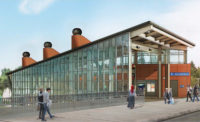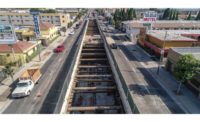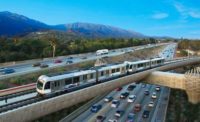An 84-in. storm drain is under the trackway in the central Mesa extension, and nine manholes were relocated outside of the trackway. Roadways also were reconstructed around the new track lines, passenger stations and relocated utilities.
In all, 31,226 ft of track, 450,000 linear ft of electrical conduit and 20,000 cu yd of track concrete were placed.
Three traction substations on the project feed the power from the city of Mesa's power grid into the light rail system. The substations convert power from alternating current to direct current and pass the energy along the catenary system. More than 150 poles support the catenary system, which includes 39,617 linear ft of messenger wire and 39,617 linear ft of overhead-contact-system wire.
Testing on the line and train systems as well as completion of the park and ride lot at the terminus near Mesa Drive are expected to be finished later this summer. Valley Metro and the city of Mesa expect to begin commuter operation on Aug. 22.
More Relocations
The northwest extension is entirely within the boundaries of the city of Phoenix. The new line continues along 19th Avenue from the previous end of the line at Montebello Avenue to Dunlap Avenue.
Work began in January 2013 and, like the Mesa extension, involved utility relocation, track and line construction and construction of four stations. Work also included demolition and reconstruction of traffic lanes and streetscape.
The bulk of the early work was focused on utilities. The Sundt and Stacy & Witbeck joint venture and third party utility companies relocated more than 500 miles of underground water, sewer, gas and electrical lines.
Of particular concern to the construction team was the 36-in. water line that had to be moved 8 to 12 ft, depending on its proximity to eventual trackway. Because the pipe was more than 60 years old and degraded, project team members recruited a master welder to complete the tie-in, according to Miller.
"One of the biggest accomplishments was connecting the new pipe to the old pipe," he says.
Unique to the extension was that four power transfer substations were prefabricated off site, placed on the pad and connected. "This is the first time that Valley Metro has done that," Miller says.











Post a comment to this article
Report Abusive Comment